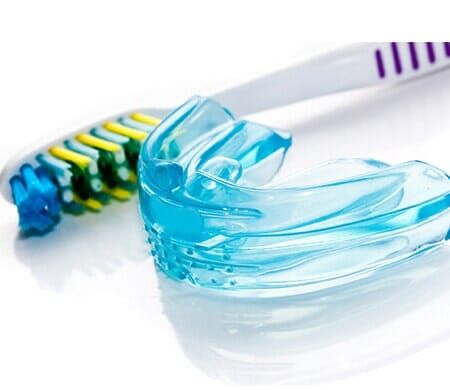TMJ (TMD) Therapy
TMJ (Temporomandibular Joint Disorders) in Moorpark, CA
What Is the Temporomandibular Joint (TMJ)?
The temporomandibular joint (TMJ)
is the hinge joint that connects the lower jaw (mandible) to the temporal bone of the skull, which is immediately in front of the ear on each side of your head. The joints are flexible, allowing the jaw to move smoothly up and down and side to side and enabling you to talk, chew, and yawn. Muscles attached to and surrounding the jaw joint control the position and movement of the jaw.
What Causes TMJ Disorders?
TMJ disorders are not uncommon and have a variety of symptoms. Patients may complain of earaches, headaches and limited ability to open their mouth. They may also complain of clicking or grating sounds in the joint and feel pain when opening and closing their mouth. What must be determined, of course, is the cause.
Determining the cause of a TMJ problem is important, because it is the cause that guides the treatment.
Arthritis is one cause of TMJ symptoms. It can result from an injury or from grinding the teeth at night. Another common cause involves displacement or dislocation of the disk that is located between the jawbone and the socket. A displaced disk may produce clicking or popping sounds, limit jaw movement and cause pain when opening and closing the mouth.
The disk can also develop a hole or perforation, which can produce a grating sound with joint movement. There are also conditions such as trauma or rheumatoid arthritis that can cause the parts of the TMJ to fuse, preventing jaw movement altogether.
The Joint, the Muscles or Both are the Problem:
Stress may trigger pain in the jaw muscles that is very similar to that caused by TMJ problems. Affected patients frequently clench or grind their teeth at night causing painful spasms in the muscles and difficulty in moving the jaw. Patients may also experience a combination of muscle and joint problems. That is why diagnosing TMJ disorders can be complex and may require different diagnostic procedures.
Treatment options
For some patients, the disorders may disappear by themselves; for others, they may come and go or may worsen over time. TMJ disorders are often managed, rather than cured. There are several ways TMJ disorders may be managed. The success of the treatment often depends upon you and Dr. Sanchez
working together to find what works to relieve your symptoms.

The following self-care practices may be recommended:
- Eating softer foods or avoiding foods that cause symptoms
- Minimize extreme jaw movements, such as yawning, yelling or singing
- Avoid chewing gum
- Modifying the pain with heat or ice packs
- Practicing relaxation techniques to control jaw tension, such as meditation
If necessary, Dr.Sanchez may recommend the following to relieve your symptoms:
- Exercises to strengthen jaw muscle
- Medicines to reduce pain or inflammation, or to help you relax
- A night guard or bite plate to decrease clenching or grinding of teeth
- In office therapy (TMJ orthopedic treatment)
In some cases, Dr.Sanchez may recommend fixing an uneven bite by adjusting or reshaping some teeth. Orthodontic/Orthopedic treatment may also be recommended.
Browse Our Website
Contact Information
Email: drgsanchezdds@aol.com
Fillmore Address:
364 Central Ave, Fillmore, CA 93015
805-524-4448
Moorpark Address:
116 Moorpark Ave, Moorpark, CA 93021
805-532-1001
364 Central Ave, Fillmore, CA 93015
805-524-4448
Moorpark Address:
116 Moorpark Ave, Moorpark, CA 93021
805-532-1001
Contact Information
Email: drgsanchezdds@aol.com
Fillmore Address:
364 Central Ave, Fillmore, CA 93015
805-524-4448
Moorpark Address:
116 Moorpark Ave, Moorpark,
364 Central Ave, Fillmore, CA 93015
805-524-4448
Moorpark Address:
116 Moorpark Ave, Moorpark,
CA 93021
805-532-1001
805-532-1001
Fillmore Address:
364 Central Ave, Fillmore, CA 93015
805-524-4448
Moorpark Address:
116 Moorpark Ave, Moorpark, CA 93021
805-532-1001
364 Central Ave, Fillmore, CA 93015
805-524-4448
Moorpark Address:
116 Moorpark Ave, Moorpark, CA 93021
805-532-1001
Images provided on this website are for personal, non-commercial use. Republication, retransmission, or reproduction of such images is strictly prohibited.
